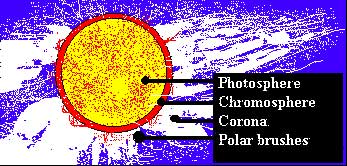
|
www.eclipse-chasers.com About Solar Eclipses Author: Bill Kramer |
Eclipse Chaser
(noun) - Anyone that wants to see a total solar eclipse.  Search Eclipse Chasers Site
Search Eclipse Chasers Site |
About Solar Eclipses
A General Introduction to Eclipses and Eclipse Terminology
 A Solar Eclipse occurs when the moon gets in the way of the sun as seen from the Earth. It is a special event to see and only visible on a small part of the Earth at any one time. The most magnificent spectacle in the sky, a total solar eclipse, is visible along a narrow (100km) corridor of the planet.
A Solar Eclipse occurs when the moon gets in the way of the sun as seen from the Earth. It is a special event to see and only visible on a small part of the Earth at any one time. The most magnificent spectacle in the sky, a total solar eclipse, is visible along a narrow (100km) corridor of the planet.
A Solar Eclipse can only happen during the lunar phase known as the New Moon. At the same time the Moon must be crossing the ecliptic. The Moon's Orbit is inclined by about five degrees relative to the ecliptic thus not every New Moon results in a solar eclipse and not every Solar Eclipse is a Total Solar Eclipse. Because eclipses are rather spectacular (even total lunar eclipses are neat to see) people have long sought after methods of predicting when the next one will be visible. Although not a simple cycle of repeating eclipse circumstances, there is something known as the Saros Series which aided early astronomers to quickly predict eclipses (mostly lunar) based on previous observations.
There is an amazing cosmic coincidence that the Moon is about 400 times closer to the Earth than the Sun. At the same time, the Sun is about 400 times larger than the Moon. What this means is that the angular size of the Sun and Moon as seen from the surface of the Earth is about the same in the sky. When viewed from the surface of Earth, both the moon and sun appear to be about one half degree in angular size – that is, about the size of your thumbnail when you extend your arm.
Because the size of the Moon and Sun in the sky is just about the same, there are times when you might see a Total Solar Eclipse and other times an Annular Solar Eclipse if you are in the right location - the central path of totality or annularity. If you are outside this path you might see a partial eclipse or no eclipse at all.
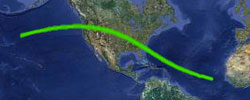 For example to see the total solar eclipse in 2017 you needed to be located along the narrow path shown in green on the map at left. If you are north or south of the green path you saw a partial eclipse.
For example to see the total solar eclipse in 2017 you needed to be located along the narrow path shown in green on the map at left. If you are north or south of the green path you saw a partial eclipse.
In astronomical terms, the Sun and Moon have roughly the same angular size. This makes it possible for a solar eclipse to occur. No other planets in our solar system enjoys the same one-to-one ratio between the size of a moon and the Sun.
The result is a very small shadow cast from the Moon onto the Earth. The shadow is in the shape of a cone. When it intersects with the planet Earth it is an oval shape about 100 miles across with a varying major axis size. There are two parts of the shadow, the umbra, the darkest part, and the penumbra, the surrounding ring that is not quite as dark. To see a total solar eclipse you must be inside the umbra. A partial eclipse is seen when you are in the penumbra.
During a Total Solar Eclipse you can see parts of the sun not normally visible to the eye such as the corona and prominences. These items are only visible during the short time between second contact and third contact of a Total Solar Eclipse.
Eclipse Chasers Terminology look up >
What is the New Moon?
The New Moon is one of the primary phases of the Moon. The primary phases are “New”, “Waxing crescent”, “First quarter”, “Waxing gibbous”, “Full”, “Waning gibbous”, “Third Quarter”, “Waning crescent”.
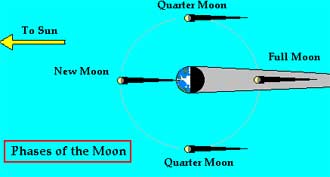
The “New” phase is when the moon is invisible from the Earth because it is at the same ecliptic longitude as the Sun. The Waning crescent is sometimes known as the old moon.
Another term for New Moon is the Dark Moon.
The New Moon is used in many calendar systems to mark the beginning of the months. A new moon occurs every about every 29 and a half days. The value varies slightly through out the year.
What is the Ecliptic?
The Ecliptic is the path through the stars that the Sun appears to trace every year. When you think of the sky as a big ball surrounding the Earth then the Ecliptic is a circular slice through the center that the Sun follows.
The Earth orbits the Sun as do all the planets and moons. Most of these objects are in orbit so they also appear to follow the ecliptic plane but with slight deviations. The deviation is expressed in terms of degrees. The orbit is described as being inclined to the ecliptic. For example the Moon’s orbit around the Earth is inclined about five degrees relative to the ecliptic.
The point where the orbit of a planet or the Moon crosses the ecliptic (intersects) is called a node. If the intersection is going towards the north then it is considered a rising node. When going towards the south it is a setting node.
 The moon's orbit is inclined 5 degrees from the ecliptic plane. That is why we do not see a solar eclipse every time there is a new moon. The angular size of the Moon is half a degree. It can miss the Sun by quite a distance.
The moon's orbit is inclined 5 degrees from the ecliptic plane. That is why we do not see a solar eclipse every time there is a new moon. The angular size of the Moon is half a degree. It can miss the Sun by quite a distance.
What is Angular Size?
Angular size is method of measuring how big something in the sky appears.
If you think of the sky as a big ball surrounding the Earth then you can imagine a grid system laid out on the ball. Since the ball is round and we don’t the know the size of it the easiest grid pattern would be degrees (or radians).
There are 360 degrees in a circle. That means that any one time you can see 180 degrees of the sky (the rest is below the horizon).
With 180 degrees from horizon to horizon then over head is 90 degrees up.
Even though you might think of the Sun and Moon as large objects in the sky they are really only about 1/2 of a degree in angular size. (That means you could fit 180 moons from the horizon to the zenith overhead.)
The Shape of the Shadow

The basic geometric shape of the shadow cast by the moon from the sun towards the Earth is a cone. The Sun is not a point source of light. It is a ball of light 400 times larger than the Moon. The Moon is 400 times closer which is why the Sun and Moon appear to be the same size. Because the Sun is bigger the shadow cast by the moon forms a cone.
If you were to take a basketball and make it a light source in a dark room. Now put a small round ball in the room. The shadow from the small round ball is a cone. The closer the balls are together the smaller the cone.
When the shadow cone first hits the Earth the shadow appears as an elongated ellipse. As the shadow moves across the Earth’s surface is becomes closer to a circle until reversing back to a an elongated ellipse.

The Earth is a third ball in the room with the illuminated basketball and small ball. It is bigger than the small ball and placed in line with both balls but further from the basketball. If the Earth ball is moved so that one side of the shadow goes across the ball the shadow is thickest at the points where the Earth ball is closer to the shadow ball. The shadow thins towards the edges of the Earth ball because that is further away (the cone shadow is smaller). As a result the longest eclipse occurs at the point where the surface is closest to the shadow ball.
What is the Saros Series?
People have always studied the sky for cycles and signs. Even in the more ancient times it was known that eclipses, specifically lunar eclipses, repeated on a somewhat regular schedule. Every 56 and a month an eclipse would appear at roughly the same time. Actually the cycles was 18 years with 11 and third days. Not an exact match, but close enough to be noticed.
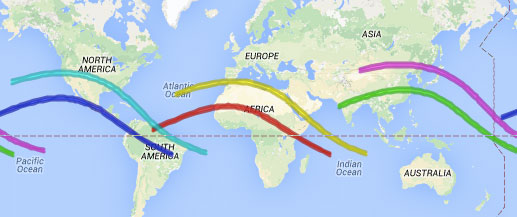 The reason for the repeating cycle is because of a match of three conditions: New moon, perigee, and nodal crossing. New moons cycle at 29.530589 days (also called a synodic month). The perigee cycles is 27.55455 days (also called an anomalistic month) and the node to node cycle is 27.212221 days (also called a draconic month). Okay, those numbers are not really close but get this, 223 synodic months almost equal 239 anomalistic months and 242 draconic months. The match ranges from 6585 days 7 hours 43 minutes, to 6585 days 12 hours 54 minutes. This is close enough for the eclipse conditions to repeat - for lunar eclipses.
The reason for the repeating cycle is because of a match of three conditions: New moon, perigee, and nodal crossing. New moons cycle at 29.530589 days (also called a synodic month). The perigee cycles is 27.55455 days (also called an anomalistic month) and the node to node cycle is 27.212221 days (also called a draconic month). Okay, those numbers are not really close but get this, 223 synodic months almost equal 239 anomalistic months and 242 draconic months. The match ranges from 6585 days 7 hours 43 minutes, to 6585 days 12 hours 54 minutes. This is close enough for the eclipse conditions to repeat - for lunar eclipses.
Turns out the Saros cycle also applies to Solar Eclipses. Every 18 years, 11.3 days a solar eclipse takes place as part of a Saros Series. The figure of the eclipse paths at left shows members of the same Saros Series ranging from 1973 to 2063. The 0.3 day difference accounts for the position of the eclipse in longitude shifting. The slight difference in draconic cycle accounts for the shifts in latitude from eclipse to eclipse. A single Saros Series goes on for over a thousand years.
Three members of the same Saros in a row are called an exeligmos cycle. That is 54 years plus about a month. As seen in the figure the eclipses do not exactly repeat. They are just shifted a bit. But if you observe a partial solar eclipse you can predict that you will see another partial solar eclipse (or maybe even a total!) in 54 years at the same spot. In ancient times such a simple prediction could be a powerful thing!
For a very complete reference regarding Saros Series see the NASA Eclipse web page: http://eclipse.gsfc.nasa.gov/SEsaros/SEperiodicity.html
Types of Solar Eclipses
 There are three types of Solar Eclipses. The most commonly seen is the Partial Solar Eclipse (PSE). During a PSE only a portion of the Sun’s surface will be covered. It will appear as if a large bite has been taken out of the Sun.
There are three types of Solar Eclipses. The most commonly seen is the Partial Solar Eclipse (PSE). During a PSE only a portion of the Sun’s surface will be covered. It will appear as if a large bite has been taken out of the Sun.
![]() When the bright surface is completely covered a Total Solar Eclipse (TSE) is taking place. Surrounding the shadow of a TSE is a PSE. Thus one sees a partial eclipse up to the total eclipse and then a partial eclipse afterwards. Only during a TSE is it safe to look at the Sun. Then you can see the corona and prominences.
When the bright surface is completely covered a Total Solar Eclipse (TSE) is taking place. Surrounding the shadow of a TSE is a PSE. Thus one sees a partial eclipse up to the total eclipse and then a partial eclipse afterwards. Only during a TSE is it safe to look at the Sun. Then you can see the corona and prominences.
 If the cone of the shadow from the Moon falls short of the surface of the Earth then an Annular Solar Eclipse (ASE) takes place. In an annular eclipse the surface of the sun is obscured across the mid section but there is still a ring of photosphere visible. It appears as a ring of file and causes very odd donut shaped pin hole projections. Like a TSE, there is a PSE surrounding the ASE location.
If the cone of the shadow from the Moon falls short of the surface of the Earth then an Annular Solar Eclipse (ASE) takes place. In an annular eclipse the surface of the sun is obscured across the mid section but there is still a ring of photosphere visible. It appears as a ring of file and causes very odd donut shaped pin hole projections. Like a TSE, there is a PSE surrounding the ASE location.
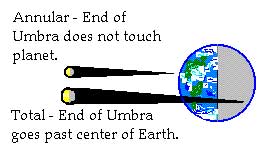
The technical definition of a total solar eclipse is one where the umbra shadow from the Moon extends past the central axis of the Earth. When the shadow does not touch the surface of the Earth the eclipse is considered annular. That means there is a gray area where an eclipse might start annular, then be total, then annular again as seen from different points of the Earth. Those eclipses are considered Annular/Total Solar Eclipses (ATSE) or Hybrid Solar Eclipses (HSE).
Eclipse Time Line
Each point in time where a new apparent intersection occurs between the Sun and Moon in the sky is called a “Contact”. Eclipses have at least two contacts known simply as first contact and last contact. These are the times when the moon first appears at the edge of the sun and when the moon last appears at the other edge. Total and Annular eclipses include a second and third contact. These are the times when the opposite edge of the moon covers (total) or appears (annular).
C1 |
First Contact | When the moon first appears against the sun |
C2 |
Second Contact | Diamond ring, total eclipse starts |
C3 |
Third Contact | Total eclipse ends, diamond ring |
C4 |
Last Contact | When the moon disappears from the sun |
The time between 2nd and 3rd contacts is the shortest and most interesting. Total eclipse time between those contacts vary from a few scant seconds up to seven minutes.
Eclipse Relative Time
There are some that argue that no matter what the time between C2 and C3, it will seem like just a few seconds (the range stated is often 8 or 15 seconds). The reason is that you are trying to see a lot, do a lot, watch a lot, and absorb it all as much as possible. At the same time you are stressed it is going to quickly, the camera operations, and that you might miss something. In retrospect it seems to pass a lot faster than it really does. (Review a video of totality and you will see what I mean).
Speaking of relative time during an eclipse, the time from C1 to C2 will move slowly. Frequent checks of the progress reveal little to no motion. Checking too often can make for a very long hour. By comparison, the time from C3 to C4, while nearly the same as that from C1 to C2, will seem to pass quickly as you celebrate the total eclipse and make plans for the next one.
Parts of the Sun
The Sun is a multiple layered entity. Deep inside the core matter is packed so dense as to cause nuclear fusion to take place. The energy produced from the fusion radiates outward until eventually it reaches a point where the density of the matter is no longer enough to contain it. Photons of energy emerge from the photosphere producing the ball of light we see in the sky. When the photosphere is completely covered as during a total solar eclipse we can see more layers. Closest to the photosphere is the chromosphere. It is red/pink in color and best seen just after second contact and before third contact. Outside the chromosphere is the corona. The corona extends out past the orbit of the Earth dimming quickly. When observed during an eclipse one can see the corona extending out several degrees from the edge of the moon.
